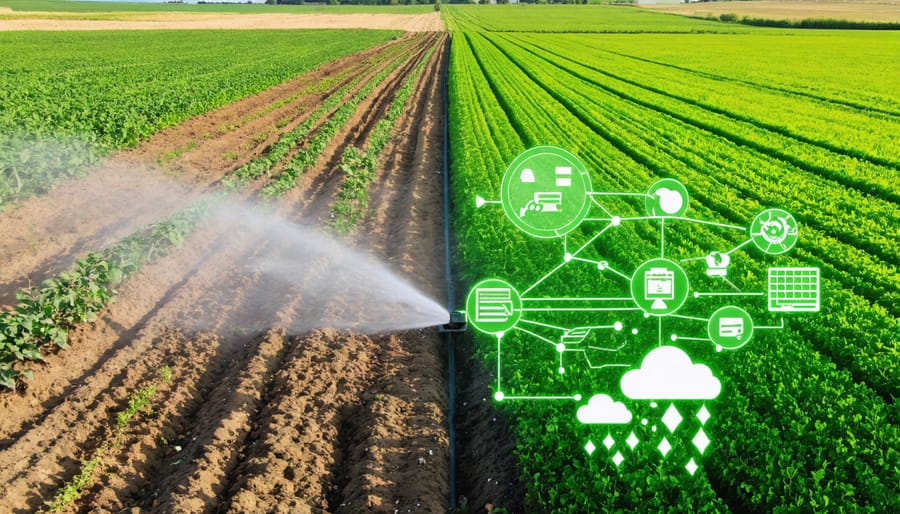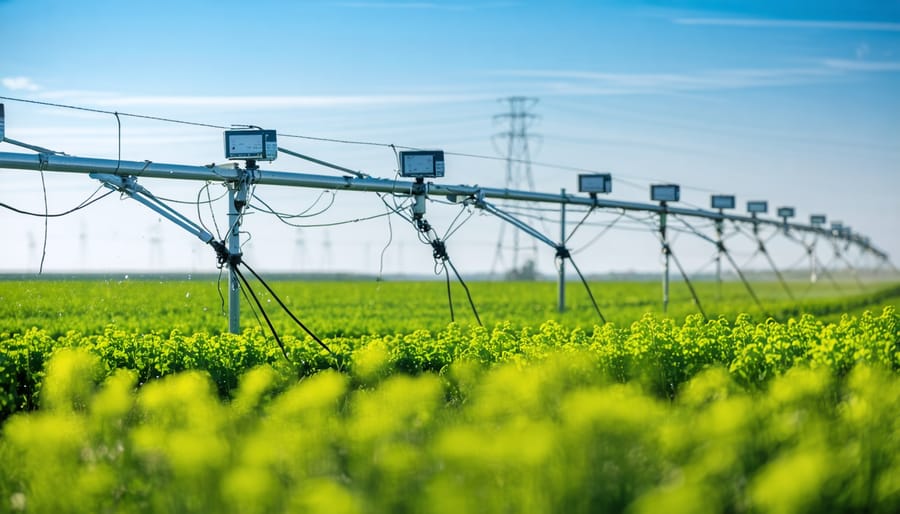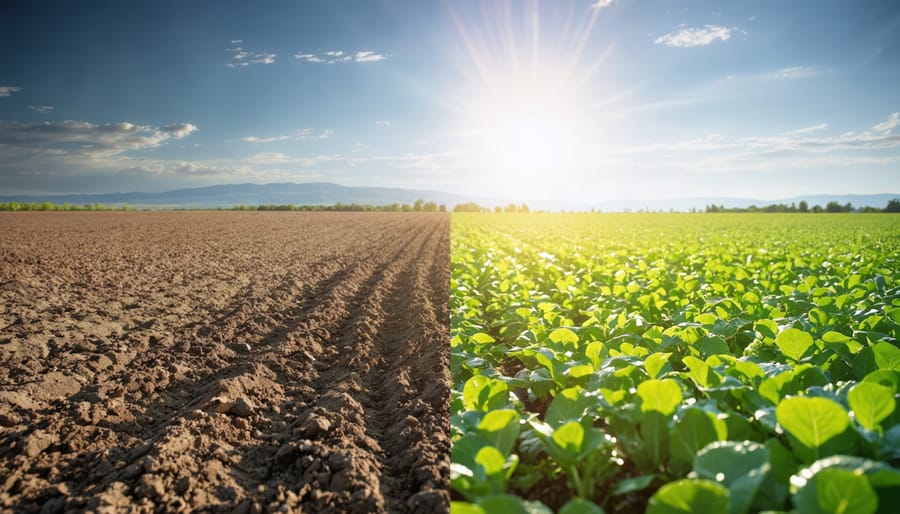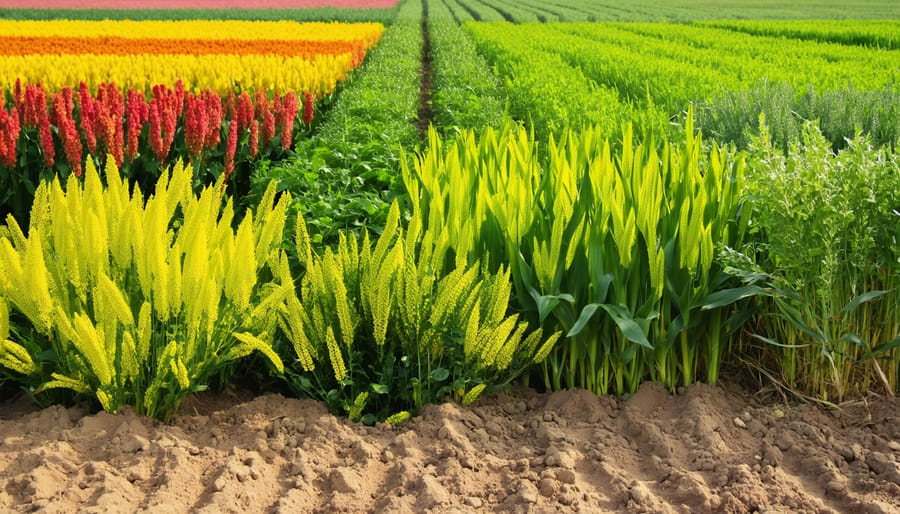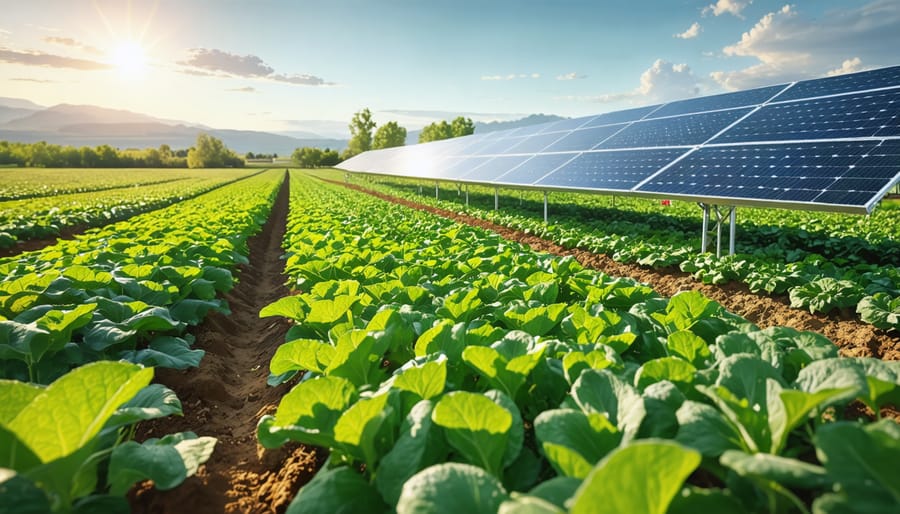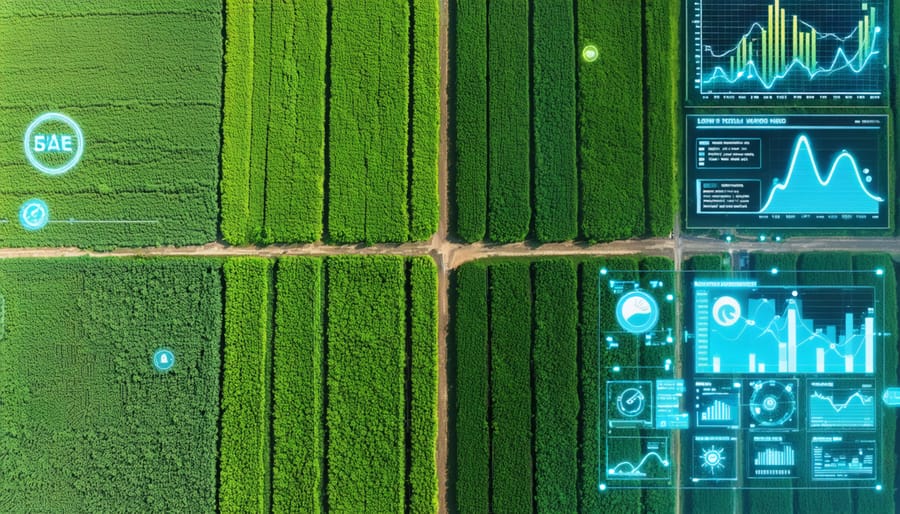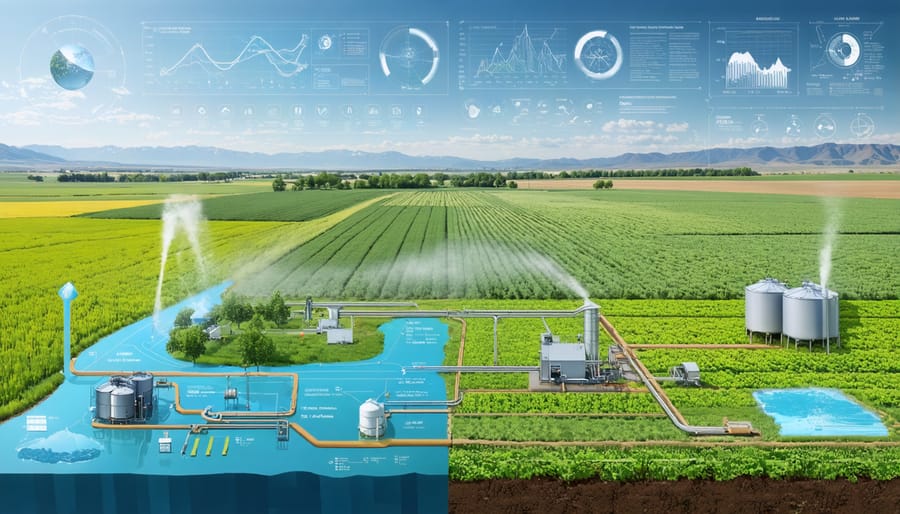Transform your farm’s water efficiency with precision irrigation systems that deliver exactly what your crops need, when they need it. In Alberta’s diverse climate, where water conservation in Alberta has become increasingly critical, smart irrigation technology reduces water usage by up to 30% while boosting crop yields by 20-25%.
Leading Alberta farmers are already seeing returns of $200-300 per hectare through precision irrigation, combining soil moisture sensors, weather data, and automated controls to optimize every drop. This technology revolution isn’t just about water savings – it’s about giving Prairie producers the tools to make data-driven decisions that protect their bottom line while preserving our vital water resources.
Whether you’re managing a small organic operation or overseeing thousands of hectares, precision irrigation systems offer scalable solutions that pay for themselves within two growing seasons. With climate variability increasing and water resources under pressure, the time to upgrade your irrigation strategy is now.
The Science Behind Precision Irrigation
Soil Moisture Sensors and Data Analytics
Modern soil moisture sensors form the backbone of precision irrigation, working alongside data analytics to revolutionize soil moisture management on Alberta farms. These sensors, strategically placed throughout fields, provide real-time moisture readings at various soil depths, helping farmers make informed irrigation decisions.
Most Alberta farmers find success with capacitance and time-domain reflectometry (TDR) sensors, which are particularly effective in our prairie soil conditions. These devices transmit data to central monitoring systems, where advanced analytics software processes the information into actionable insights.
The collected data reveals patterns in soil moisture depletion, helping predict when specific areas need irrigation. Many local farmers report saving 20-30% on water usage after implementing sensor networks. The systems also track soil temperature and electrical conductivity, providing a comprehensive view of soil health.
For best results, combine sensor data with weather forecasts and crop-specific water requirements. Modern analytics platforms can integrate this information to generate irrigation schedules tailored to your field’s unique conditions, ensuring optimal water use efficiency while maintaining crop health.
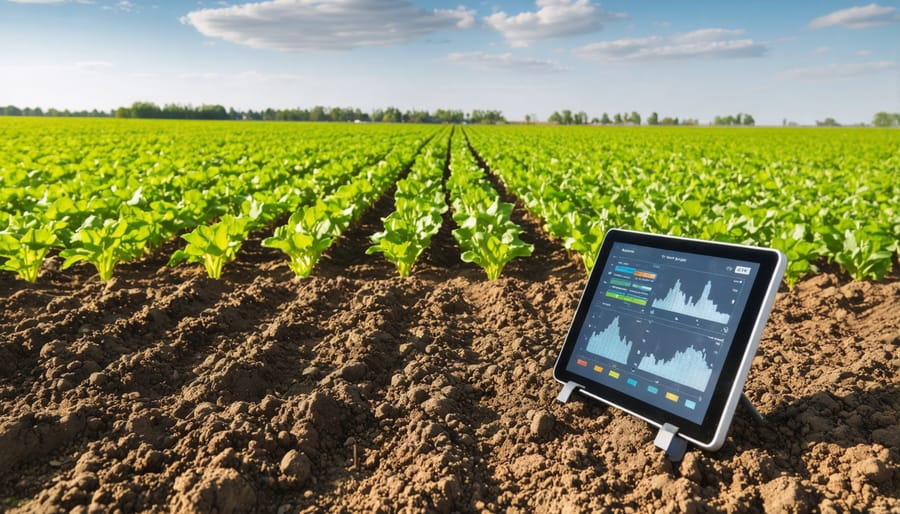
Weather Integration Systems
Modern weather integration systems are revolutionizing how Alberta farmers make irrigation decisions. By connecting to local weather stations and Environment Canada data feeds, these systems provide real-time information about rainfall, temperature, wind speed, and humidity levels specific to your farm’s location.
The integration works by combining historical weather patterns with current conditions and forecasts to determine optimal irrigation scheduling. For instance, if the system detects incoming rainfall, it automatically adjusts irrigation plans to prevent overwatering. Many Alberta farmers report water savings of 20-30% through weather-smart irrigation management.
Key weather parameters that influence irrigation decisions include evapotranspiration rates, precipitation forecasts, and soil moisture trends. These systems can also account for microclimates within your fields, ensuring more precise water distribution where it’s needed most.
Local success stories include the Turner Valley Farm, which reduced water usage by 25% in their first season using weather-integrated irrigation. The system proved particularly valuable during last summer’s dry spell, helping maintain crop health while conserving water resources.
Remember to regularly calibrate your weather sensors and keep them clean for accurate readings. Most systems now offer mobile alerts, helping you stay informed about changing weather conditions that might affect your irrigation schedule.
Real Benefits for Alberta Organic Farmers
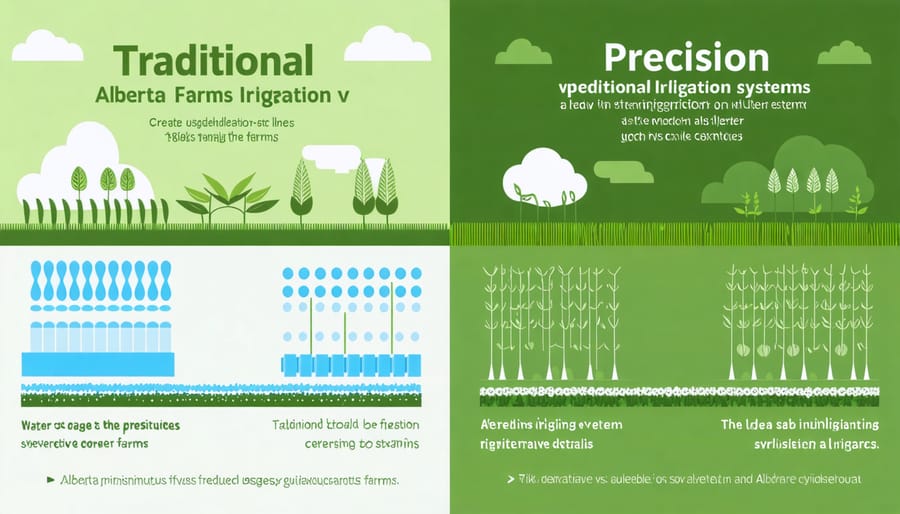
Water Conservation Success Stories
At the Riverbend Organic Farm near Lethbridge, Sarah Thompson reduced water usage by 40% in her first year after implementing precision irrigation on her 20-hectare vegetable operation. “The soil moisture sensors helped us discover we were actually overwatering our root vegetables,” Thompson explains. “Now we’re saving water and seeing better crop quality.”
In Red Deer County, the Miller Family Farm transformed their struggling 15-hectare market garden using precision drip irrigation combined with weather monitoring stations. Their system now automatically adjusts water delivery based on real-time soil conditions and weather forecasts. “Our water bills dropped by half, and our tomato yield increased by 30%,” shares Dave Miller.
The success extends to larger operations too. Prairie Sky Organics, operating 200 hectares near Medicine Hat, implemented precision pivot irrigation in 2021. They installed variable-rate nozzles and soil moisture sensors across different soil zones. Farm manager Mike Chen reports, “We’re using 35% less water while maintaining yield targets. The system paid for itself in just two seasons through water and energy savings.”
These farms demonstrate how precision irrigation technology adapts to different scales and crop types while delivering consistent benefits: reduced water consumption, improved crop quality, and significant cost savings.
Cost Savings and ROI Analysis
Implementing a precision irrigation system represents a significant upfront investment, but Alberta farmers consistently report substantial returns through water and resource savings. Based on local case studies, most farms see a return on investment within 2-3 growing seasons.
A typical 160-acre operation can expect initial costs between $65,000 to $85,000 for a complete system, including sensors, controllers, and software. However, annual water savings typically range from 25% to 40%, translating to approximately $12,000 to $15,000 in reduced water costs alone. Additional savings come from decreased energy consumption, reduced fertilizer waste, and lower labour costs.
Real-world data from the Lethbridge region shows that farms using precision irrigation systems reduced their operational costs by an average of 30% while increasing crop yields by 15-20%. Factor in government incentives through the Canadian Agricultural Partnership (CAP) program, which can cover up to 30% of equipment costs, and the financial picture becomes even more attractive.
Beyond direct cost savings, precision irrigation systems offer long-term benefits through improved soil health and reduced environmental impact. Many Alberta farmers report increased property values and enhanced crop insurance terms after implementing these systems. When considering ROI, it’s crucial to factor in these indirect benefits alongside immediate cost savings.
Remember to consult with local agricultural extension services for detailed cost-benefit analyses tailored to your specific operation and conditions.
Implementation Guide for Your Farm
System Selection and Setup
Selecting the right precision irrigation system requires careful consideration of your farm’s unique characteristics and needs. Here in Alberta, we’ve seen remarkable success with innovative irrigation techniques that are tailored to specific soil types and crop requirements.
For small-scale operations (under 100 hectares), drip irrigation systems often prove most effective. These systems typically include a central control unit, pressure regulators, filtration systems, and drip lines. Consider starting with a basic smart controller that offers soil moisture sensing and weather monitoring capabilities.
Medium to large farms benefit from center pivot systems equipped with variable rate irrigation technology. These systems should include GPS guidance, flow meters, and precision sprinklers. For optimal results, invest in soil moisture sensors placed at different depths throughout your fields.
When choosing components, prioritize:
– Weather-resistant materials suitable for Alberta’s climate
– Compatible software systems that integrate with your existing farm management tools
– Scalable solutions that can grow with your operation
– Energy-efficient pumps and motors
– User-friendly control interfaces
Local suppliers often provide installation support and maintenance services, which is crucial for system longevity. Many Alberta farmers have found success with systems that combine multiple sensing technologies, such as soil moisture probes and aerial imagery, to create comprehensive irrigation management solutions.
Remember to factor in your water source capacity, power availability, and terrain variations when selecting system components. Starting with a pilot area of 5-10 hectares allows for testing and optimization before expanding to full implementation.
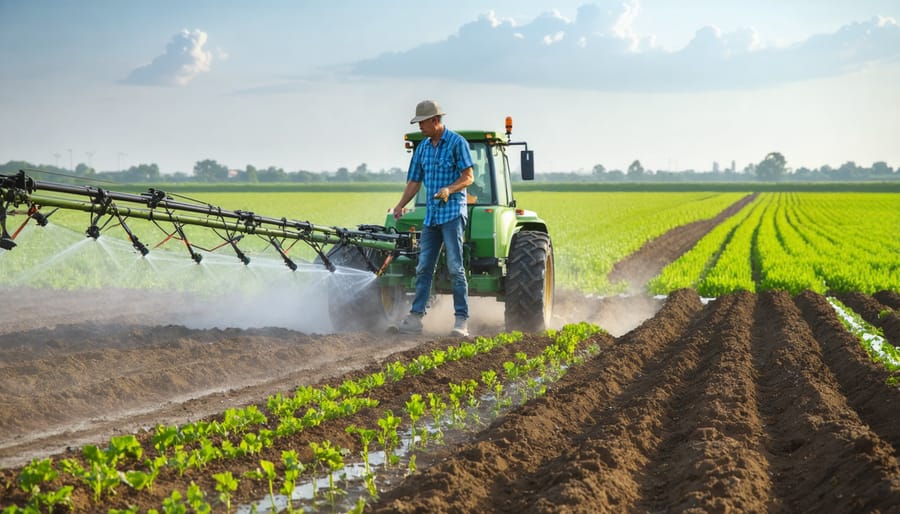
Maintenance and Monitoring
Regular maintenance and monitoring are crucial for keeping your precision irrigation system running efficiently throughout the growing season. Start each day by checking system pressure readings and inspecting for any obvious leaks or damaged components. A quick walk-through of your fields can help spot any irregularities in water distribution or equipment performance.
Weekly maintenance should include cleaning filters and checking moisture sensors for accurate readings. In Alberta’s conditions, particularly during dusty periods, sensors may need more frequent cleaning to maintain accuracy. Many local farmers have found success by scheduling comprehensive system checks every Sunday evening, preparing for the week ahead.
Monitor your system’s data regularly through its management software. Look for unusual patterns in water usage or pressure variations that might indicate problems. Keep detailed records of maintenance activities, repairs, and system adjustments – this information proves invaluable for troubleshooting and planning future improvements.
During winter months, proper system winterization is essential. Drain all components thoroughly and protect sensitive electronics from freeze damage. Consider joining local farmer networks to share maintenance tips and experiences – many Alberta producers have developed effective strategies for protecting their systems during harsh prairie winters.
Remember to calibrate sensors and flow meters at least twice during the growing season. This ensures your system continues to deliver precise amounts of water when and where needed, maintaining optimal efficiency and crop health.
Integration with Organic Farming Practices
Precision irrigation systems seamlessly integrate with organic farming practices, creating a powerful synergy that enhances both water efficiency and soil health. For Alberta’s organic farmers, this integration has proven particularly valuable in maintaining certification requirements while optimizing resource use.
The system’s ability to deliver precise water amounts helps prevent over-irrigation, which can lead to nutrient leaching – a crucial consideration in organic operations where soil biology is paramount. Many Alberta organic farmers report that precision irrigation has helped them maintain ideal soil moisture levels for beneficial microorganisms while reducing the risk of fungal diseases that can compromise organic crop health.
Local farmer Sarah Thompson from Lethbridge notes, “Since implementing precision irrigation on our organic vegetable farm, we’ve seen improved soil structure and better nutrient retention. The system helps us maintain consistent moisture levels, which is essential for our beneficial insects and soil microbes.”
The technology also supports cover cropping strategies, allowing farmers to establish green manures more effectively by providing optimal moisture during critical germination periods. This enhancement of soil-building practices aligns perfectly with organic principles while improving water conservation efforts.
For organic operations transitioning to precision irrigation, the system can be programmed to account for specific organic amendments and their water retention properties. This customization ensures that irrigation schedules complement natural soil-building processes rather than working against them.
Additionally, the data collected through precision irrigation systems helps organic farmers document their water usage for certification purposes while providing valuable insights for crop rotation planning. This documentation can be particularly useful during organic inspections and for long-term sustainability planning.
Our research with the Organic Agriculture Centre of Alberta shows that farms using precision irrigation in organic systems typically reduce their water usage by 25-30% while maintaining or improving yield quality, demonstrating that technology and organic principles can work hand in hand for better agricultural outcomes.
Precision irrigation systems represent a significant step forward for Canadian agriculture, offering our farming communities a practical solution to water conservation while maximizing crop yields. As we’ve explored throughout this article, these systems combine advanced technology with traditional farming wisdom to create more sustainable and profitable operations.
The evidence from Alberta farms shows that implementing precision irrigation can reduce water usage by up to 30% while improving crop quality and yield consistency. For many of our local farmers, the initial investment has paid off through reduced operational costs and increased productivity within just a few growing seasons.
Taking the first step toward precision irrigation doesn’t have to be overwhelming. Start with a soil moisture monitoring system and gradually build up to more advanced components as you become comfortable with the technology. Remember, your local agricultural extension office and farming community are valuable resources for guidance and support.
By embracing precision irrigation, you’re not just investing in your farm’s future – you’re contributing to the sustainable development of Canadian agriculture. Together, we can build a more resilient and water-wise farming community for generations to come.

